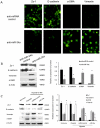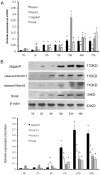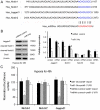Hypoxia-induced down-regulation of microRNA-34a promotes EMT by targeting the Notch signaling pathway in tubular epithelial cells
- PMID: 22363487
- PMCID: PMC3281867
- DOI: 10.1371/journal.pone.0030771
Hypoxia-induced down-regulation of microRNA-34a promotes EMT by targeting the Notch signaling pathway in tubular epithelial cells
Abstract
Background: Hypoxia-induced renal tubular cell epithelial-mesenchymal transition (EMT) is an important event leading to renal fibrosis. MicroRNAs (miRNAs) are small non-coding RNA molecules that bind to their mRNA targets, thereby leading to translational repression. The role of miRNA in hypoxia-induced EMT is largely unknown.
Methodology/principal findings: miRNA profiling was performed for the identification of differentially expressed miRNAs in HK-2 cells under normal and low oxygen, and the results were then verified by quantitative real time RT-PCR (qRT-PCR). The function of miRNAs in hypoxia-induced renal tubular cell EMT was assessed by the transfection of specific miRNA inhibitors and mimics. Luciferase reporter gene assays and western blot analysis were performed to validate the target genes of miR-34a. siRNA against Jagged1 was designed to investigate the role of the miR-34a-Notch pathway in hypoxia induced renal tubular cell EMT. miRNA-34a was identified as being downregulated in hypoxic renal tubular epithelial cells. Inhibition of miR-34a expression in HK-2 cells, which highly express endogenous miR-34a, promoted a mesenchymal phenotype accompanied by reduced expression of the epithelial marker Z0-1, E-cadherin and increased expression of the mesenchymal markers α-SMA and vimentin. Conversely, miR-34a mimics effectively prevented hypoxia-induced EMT. Transfection of miRNA-34a in HK-2 cells under hypoxia abolished hypoxia-induced expression of Notch1 and Jagged1 as well as Notch downstream signals, such as snail. Western blot analysis and luciferase reporter gene assays showed direct evidence for miR-34a targeting Notch1 and Jagged1. siRNAs against Jagged1 or Notch1 effectively prevented miR-34a inhibitor-induced tubular epithelial cell EMT.
Conclusions/significance: Our study provides evidence that the hypoxia-induced decrease of miR-34a expression could promote EMT in renal tubular epithelial cells by directly targeting Notch1 and Jagged1, and subsequently, Notch downstream signaling.
Conflict of interest statement
Figures






Similar articles
-
Detrimental effects of Notch1 signaling activated by cadmium in renal proximal tubular epithelial cells.Cell Death Dis. 2014 Aug 14;5(8):e1378. doi: 10.1038/cddis.2014.339. Cell Death Dis. 2014. PMID: 25118938 Free PMC article.
-
MicroRNA-34a suppresses invasion through downregulation of Notch1 and Jagged1 in cervical carcinoma and choriocarcinoma cells.Carcinogenesis. 2010 Jun;31(6):1037-44. doi: 10.1093/carcin/bgq066. Epub 2010 Mar 29. Carcinogenesis. 2010. PMID: 20351093
-
Micro-vesicles from mesenchymal stem cells over-expressing miR-34a inhibit transforming growth factor-β1-induced epithelial-mesenchymal transition in renal tubular epithelial cells in vitro.Chin Med J (Engl). 2020 Apr 5;133(7):800-807. doi: 10.1097/CM9.0000000000000720. Chin Med J (Engl). 2020. PMID: 32149762 Free PMC article.
-
Blockade of Jagged/Notch pathway abrogates transforming growth factor β2-induced epithelial-mesenchymal transition in human retinal pigment epithelium cells.Curr Mol Med. 2014 May;14(4):523-34. doi: 10.2174/1566524014666140331230411. Curr Mol Med. 2014. PMID: 24694299 Review.
-
ΔNp63α and microRNAs: leveraging the epithelial-mesenchymal transition.Oncotarget. 2017 Jan 10;8(2):2114-2129. doi: 10.18632/oncotarget.13797. Oncotarget. 2017. PMID: 27924063 Free PMC article. Review.
Cited by
-
Hypoxia: a master regulator of microRNA biogenesis and activity.Free Radic Biol Med. 2013 Sep;64:20-30. doi: 10.1016/j.freeradbiomed.2013.05.022. Epub 2013 May 24. Free Radic Biol Med. 2013. PMID: 23712003 Free PMC article. Review.
-
P53‑microRNA interactions regulate the response of colorectal tumor cells to oxaliplatin under normoxic and hypoxic conditions.Oncol Rep. 2023 Dec;50(6):219. doi: 10.3892/or.2023.8656. Epub 2023 Nov 3. Oncol Rep. 2023. PMID: 37921068 Free PMC article.
-
Investigating the inhibitory effect of miR-34a, miR-449a, miR-1827, and miR-106b on target genes including NOTCH1, c-Myc, and CCND1 in human T cell acute lymphoblastic leukemia clinical samples and cell line.Iran J Basic Med Sci. 2020 Mar;23(3):376-382. doi: 10.22038/IJBMS.2019.40695.9615. Iran J Basic Med Sci. 2020. PMID: 32440325 Free PMC article.
-
Detrimental effects of Notch1 signaling activated by cadmium in renal proximal tubular epithelial cells.Cell Death Dis. 2014 Aug 14;5(8):e1378. doi: 10.1038/cddis.2014.339. Cell Death Dis. 2014. PMID: 25118938 Free PMC article.
-
Metformin inhibits gastric cancer cells metastatic traits through suppression of epithelial-mesenchymal transition in a glucose-independent manner.PLoS One. 2017 Mar 23;12(3):e0174486. doi: 10.1371/journal.pone.0174486. eCollection 2017. PLoS One. 2017. PMID: 28334027 Free PMC article.
References
-
- Winter J, Jung S, Keller S, Gregory RI, Diederichs S. Many roads to maturity: microRNA biogenesis pathways and their regulation. Nat Cell Biol. 2009;11:228–234. - PubMed
-
- Ambros V. MicroRNA pathways in flies and worms: Growth, death, fat, stress, and timing. Cell. 2003;113:673–676. - PubMed
-
- Liu Y. Epithelial to mesenchymal transition in renal fibrogenesis: Pathologic significance, molecular mechanism, and therapeutic intervention. J Am Soc Nephrol. 2004;15:1–12. - PubMed
Publication types
MeSH terms
Substances
LinkOut - more resources
Full Text Sources
Other Literature Sources
Research Materials

